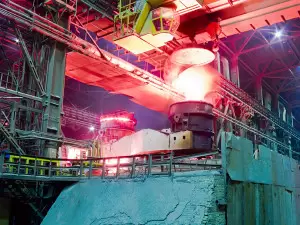
Metallurgy is the study of the properties of metals, and the application of this study to metal recovery, production, purification, and use.
Metallurgists are materials scientists who specialize in metals such as steel, aluminum, iron, and copper. They often work with alloys - metals that are mixed with each other or other elements - to create materials with specific desirable properties. They're also referred to as metallurgical engineers or material science engineers.
What Does a Metallurgist Do?
Metallurgists deal with extracting and processing metals. They examine the performance of metals, and determine which ones can be put to which uses.
Chemical metallurgists test ores to determine the recoverability of metals from them, and design processes to recover them efficiently. They also monitor metal corrosion and fatigue, and develop ways to strengthen metals. They may also test metals to ensure they're of acceptable quality.
Physical metallurgists monitor the behavior of metals under stress, and write reports on test results. They also investigate accidents potentially caused by metallurgical failure.
Process metallurgists design metal parts and control the processes through which they're shaped, such as casting. They also weld and solder metal parts together.
Metallurgists interested in the environment can help design cleaner, less wasteful processes that produce less slag to be landfilled. They can also help optimize product designs so that they're lighter, requiring fewer resources to produce and less fuel to transport.
Where Does a Metallurgist Work?
Metallurgists spend most of their time in offices and laboratories, and may also work “on the floor” in manufacturing facilities. The U.S. Bureau of Labor Statistics (BLS) groups metallurgists with materials engineers. As of 2012, 19% of materials engineers worked in aerospace product and parts manufacturing. 10% worked in architectural, engineering, and related services. Another 7% worked in scientific research and development services. 6% were employed in semiconductor and other electronic component manufacturing, and another 6% were employed by the federal government.
They usually work full time during standard business hours, but may need to work overtime occasionally.
What Is the Average Metallurgist Salary?
BLS reported the median annual wage for metallurgists was $93,800 as of May 2020. Those employed by the oil and gas extraction earned the highest salaries ($138,380). Those working in the government sector earned a median salary of $120,100.*
Metallurgist Jobs & Job Description
Metallurgists work to mold or combine metals in order to create certain desired shapes or properties. Metallurgy also focus on making and compounding alloys and separating metals from their ores. While jobs do vary, most metallurgists discover that the following list of tasks falls under their scope of practice:
- Review peer research and journals discussing to current discoveries in the field
- Collect field and control samples of media and metals in order to perform analyses
- Evaluates, recommends and implements metallurgical sampling and analysis
- Identifies and reports on metallurgical or processing issues
- Consults with recommendations to correct, mitigate or improve processes
- Implement best procedures for use in metallurgical analysis
- Prepare and aggregate reports containing highly technical data to internal and external stakeholders
- Document and communicate results of technical data
- Engage in predictive computer modelling for metallurgical engineering
- Ensure that proper health and safety documentation is generated for projects and tasks and is consistent with engineering policies and procedures
Senior metallurgists often have more responsibilities that include management of a lab or field site and team. Such responsibilities often include:
- Act as Project Manager for departmental or field process improvements
- Delegate or complete daily and weekly production and consumables inventory management
- Complete monthly production and inventory reports as part of a cross-disciplinary team consisting of business and technical staff
- Analyze, design, and test components, assemblies or systems that meet business standards and program / product requirements
- Create a challenging and positive team environment ensuring that junior members receive the professional development and mentorship that will in turn have them become industry leaders
- Consult with policymakers regarding research and interdisciplinary issues that may affect national and international policy
- Navigate regulatory issues as they apply to fieldwork and site development
- Address specific organizational initiatives with internal stakeholders
- Share engineering best practices and promote open dialogue on an international level
- Protect proprietary or developing technology that provides a competitive advantage to the business
What Is the Job Demand for Metallurgists?
The job demand for materials engineers is expected to grow by 4 percent between 2020 and 2030. This is partly due to declining employment in the manufacturing sector. However, some jobs will open up as older workers retire.*
What Metallurgist Careers Are Available?
Eventually, materials engineers may become technical specialists or advance to supervisory positions. They may also use their technical expertise to help customers plan and install products as sales engineers.
How Do I Get a Metallurgist Degree?
Materials engineers usually must have at least a bachelor's degree in materials science or engineering. Students typically take courses in engineering, mathematics, calculus, chemistry, and physics. Laboratory work is also required. Some engineering schools offer cooperative 5-6-year programs that combine coursework with job experience. These programs, as well as any other type of hands-on experience, are highly valued by prospective employers.
Some colleges offer a 5-year program leading to both a bachelor's and master's degree. Graduate degrees open up opportunities in research and development, and are sufficient for employment as an instructor at some colleges. A degree from an ABET-accredited program is often preferred by prospective employers, and usually required for becoming a licensed professional engineer.
Related Degree Options for Metallurgists
Metallurgist Licensure
Engineers who offer their services directly to the public must be licensed as professional engineers (PEs). Licensure generally requires:
- A degree from an ABET-accredited engineering program
- A passing score on the Fundamentals of Engineering (FE) exam
- Relevant work experience, typically at least 4 years
- A passing score on the Professional Engineering (PE) exam
College graduates may take the Fundamentals of Engineering (FE) exam immediately. Engineers who pass this exam are called engineers in training (EITs) or engineer interns (EIs). After gaining four years of work experience, EITs and EIs can go on to take the Principles and Practice of Engineering exam to qualify for licensure.
Several states require engineers to participate in professional development activities in order to keep their licenses. Most states recognize licensure from other states, as long as that state's requirements meet or exceed their own licensure requirements.
Certification in metallography is available through ASM International and similar organizations. Metallurgists can also receive additional training and professional development in metallurgy and materials, including specific techniques, through ASM.
What Kind of Societies and Professional Organizations Do Metallurgists Have?
- ASM International, founded as the American Society for Metals in 1913, is the largest association for metals-oriented materials scientists. ASM offers professional development courses and certification in metallography. It issues well-known materials standards, organizes databases and publishes journals, and hosts online communities for colleges and universities and emerging professionals.
- The Society for Mining, Metallurgy, & Exploration organizes an Environmental Division and a Mineral & Metallurgical Processing Division. It provides networking opportunities through its divisions and an annual conference. It also organizes a mentor program and student chapters. It shares technical information by publishing books, magazines, and journals and managing a database of articles. It offers e-learning opportunities, funds awards, and hosts an online Student Center.
*2020 US Bureau of Labor Statistics salary figures and job growth projections for mining and geological engineers reflect national data not school-specific information. Conditions in your area may vary. Data accessed September 2021.





